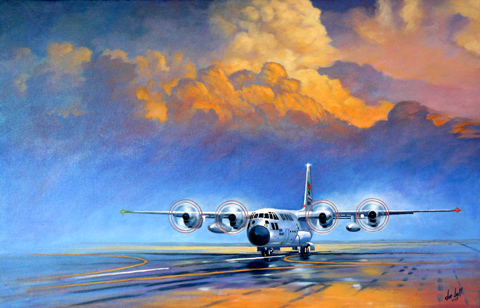FASTER COMBAT POWER, LESS EXPOSURE IN THE ASSAULT ZONE
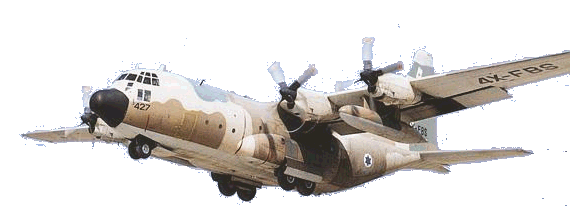
From: xxxxxxxxxxxxx
Sender: owner-c130mail@spectrumwd.com
To: c130mail@spectrumwd.com
"Here is what I remember about the Dominican Republic thing: My version differs from POWER PACK I. As I recall, the 144 airplanes that took-off 15, seconds apart, out of Pope that night, and they were headed for San Isidro. All the planes were rigged for air drop, when true to LBJ form, they were told enroute not to air drop, but land instead. Since only a few could land on that tiny little air field, the rest diverted to Ramey AB. There were so many C-130s the ground facilities at Ramey AB were overwhelmed..."
Dash-te-Kavir desert. 1980.
"Desert ONE". 1980. Iran holding Americans hostage.
Most of us are aware of the unqualified Mcpilots flying malfunctioning Navy RH-53D helicopters to the "Desert One" staging site, one turning back to the carrier due to a dust storm and one crashing into an EC-130 tanker aircraft killing 3 McAircrew and 5 USAF Aircrewmen, described in detail by the Eagle Claw mission commander, Col. James Kyle in his book; "The Guts to Try". What most do not know is that a second mission not involving helicopters was planned.
The second mission was based on multiple rockets to fly fixed wing C-130 Hercules aircraft into the Iranian soccer stadium AND OUT.

www.youtube.com/watch?v=UxfpGPWtoOY
VIDEO HAS NO SOUND, SO ENJOY THE WEB PAGE MUSIC!
Steve Douglas writes in his Credible Sport web site:
Military strategists examined other successful hostage rescue raids and in particular, the Israeli's raid on Entebbe. In the daring raid, the Israelis, landed at the Entebbe airport in C-130s, commandos attacked their jailers and freed the hostages, loaded them on the transports and were back in Israeli airspace before anyone knew what had happened. What was needed was an Entebbe style raid.
Tehran was not Entebbe, planners pointed out. The Entebbe hostages were being held in a building adjacent to the airport, the Tehran hostages were being held at the U.S. Embassy and several other locations. The closest airport to the embassy compound was Tehran airport, and landing a U.S. commando force there was out of the question.
The closest thing to a landing spot near the embassy was the embassy soccer field. In the original raid, the soccer field was to be used as an LZ for the helicopters, but helicopters were ruled in any future out because they had proven unreliable in the failed first attempt.
Somebody, somewhere in the black world had a brainstorm. Could a C-130 be modified to land in a soccer field with thirty foot obstructions at both ends and could the same aircraft take off from such a field? If it could, then a second rescue attempt just might be possible.
The commandos could be on those special C-130s. They could land right next to the embassy, locate and free the hostages and take off without ever going near the Tehran airport. Such a small field could be easily defended and the site of a vertical landing C-130 gunship filled with armed-to-the-teeth commandos would most likely make even the most hardened terrorist think twice about a confrontation. It sounded far fetched, but maybe, just maybe it could work. All that was needed was to turn a huge C-130 Hercules into a helicopter.
"Necessity is the mother of invention".
"Was it possible to mount another rescue attempt? What would it take and how many men were questions the Pentagon began asking it's military think tanks. Iran had reacted to the raid by dispersing some of the hostages, but if they could be located by CIA operatives and if commandos could get in and out easily and as simply as possible, a plan might be feasible.
When the military needs to pull off the impossible they call Lockheed. Then Under Secretary of Defense for Research and Engineering, William Perry did just that and Credible Sport was born.
The program goal? To modify three C-130s to be able to land on a football sized field obstructed by two 33 foot structures on both ends and to be able to take off, fully loaded with troops passengers and supplies from the same field.
Dr. Perry had the Air Force provide three C-130H airframes and $25M for each aircraft to be modified by Georgia, Lockheed.
The extensive modifications to the aircraft included:
1. A terrain following radar borrowed from the A-7 Corsair II
2. Chin-mounted FLIR (Forward Looking Infrared) sensors integrated with a navigation computer.
3. Dorsal and horsal extensions (rudder and elevator leading edge extensions at fuselage junction)
4. Flap and aileron extensions (for better low speed handling)
5. Avionics package to provide glide-path guidance.
6. Rocket motors to aid take-off and landing performance: 8 Mk-6s for takeoff thrust, 8 SHRIKE motors to reduce landing rate of sink, 8 forward facing ASROC motors for deceleration, 6 ASROC motors for pitch/yaw control.
Other modifications included storing the forward facing rocket motors behind aerodynamic fairings while in flight.
From the shopping list of spare parts needed for Credible Sport, it's mission was obvious. Fly at low-level using the terrain following radar to avoid detection. Fly at night using the chin mounted FLIR to locate the landing field. A steep approach and descent to the LZ would be controlled by the forward firing the rockets slowing any forward motion to almost zero.
The powerful SHRIKE rocket motors would control rate of sink and land the huge cargo aircraft like a spaceship touching down on the moon. Six ASROC rocket motors would dampen pitch and yaw.
After the commandos had completed their mission they would board the C-130s and blast their way out in much the same way they came in.
Once at altitude, normal propelled horizontal flight would resume.
Just imagine it. A huge lumbering C-130 Hercules, spitting fire and rocket exhaust and landing like Harrier. It seemed impossible.
And yet it worked. The first successful flight test occurred on Sept. 18, 1980 only 60 or so days after modifications were begun. Video tape taken of the test showed the C-130 firing its rockets and making a rough but successful landing in the space required. The go ahead was given to modify two more C-130s for a total of three Credible Sport (then renamed "Coronet Bat") aircraft.
But then disaster struck. On October 29, 1980 as the first prototype was on a test approach and landing one of the SHRIKE rocket motors fired prematurely, ripping off the left wing.
The aircraft hit the ground hard and came apart in a spectacular fireball. Luckily the cockpit was severed from the rest of the aircraft throwing the pilots clear of the burning plane. Both were injured but survived the crash.
The program was cancelled not much later after President Reagen's election returned the hostages.
More on Credible Sport:
How many rockets can make plane land like a chopper?
Jane's reveals Iran hostage crisis engineering feat
March 3, 1997 Web posted at: 11:50 p.m. EST
From Correspondent Richard Blystone
COMBAT ENGINEER SAPPERS TO CLEAR DROP ZONES TO MAKE ASSAULT LANDING ZONES
Details on the link above!
WHY NOT JATO FOR DOWNWIND TAKE-OFFS?
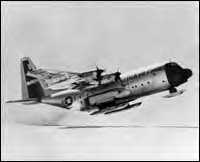

From Maleme Airfield during the battle for Crete in WWII to Grenada in 1983, airland operations are slowed by the bottleneck of one plane landing at a time and then unloading which increases exposure to enemy fire. DoD vernacular: "MOG rates", or "Maximum aircraft On the Ground". Airdrop is superior because we get instantaneous combat power/mass on the Drop Zone (DZ) and the plane flies away in seconds. However after the drop, the area is cleared of air items and becomes an Assault Zone (AZ) for Airlanding troops who are not trained to be Paratroopers like the 10th Mountain and 25th Tropic Lightning, and 101st Air Assault LIDs. Its better to Airland mechanically fickle and shorter-range helicopters by fixed-wing aircraft for Special Operations--like Operation Eagle Claw. In 1980, we should have flown helicopters by C-130s/C-141s to Manzariyeh airfield not tried to fly them under their own power long distance from aircraft carriers to a dusty Desert One. Then helicopters could have been offloaded from the C-130s or larger C-141s to fly a shorter distance to retrieve at the soccer field a Delta Force that had first PARACHUTED IN to meet hidden compartment trucks and rescued hostages. C-17s and C-130s can assault zone STOL airland massed U.S. Army Aviation units for AirMECHanized capabilities in conventional battles. This is the future of war: Airborne, not seaborne. The problem is time wasted on the ground unloading and taxiing aircraft.
The first question is, why not have the C-130 at the end of its landing roll turn around and take-off DOWNWIND instead of taxiing back to an upwind take-off spot, which takes time, kicks up dust clouds, and exposes the Herk to more enemy fire? If necessary, use JATO for added lift to help up an empty plane.
An Argentinian AF C-130 pilot writes:
JATO's were commonly used to take off from short runways. I don't think you would earn much time taking off with JATO from a long runway. Missiles and fighters fly faster.
I hope this answer your question. Excuse my english."
A USAF Command C-130 Instructor pilot writes:
I'm pretty sure that no Air Force slick C-130 units still use JATO. Nor are they likely to: the rockets are hazardous equipment, about like munitions, and that's just a pain to deal with; it'd be an extra training & currency requirement, and it really doesn't get you that much -- about any field you can land on you can usually get out of in a Herk (tho you probably are using everything you have to do it -- i.e. into the wind both ways). So I don't think the answer to your question is ever going to be JATO. As far as having people take off downwind, it all depends. With a dry 4000' strip and an empty plane about half full of gas, yeah, I could probably accept a 10 knot tailwind on most days. But, same strip, wet from rain, with stuff still on the plane and more gas, gusty winds, and a hot day, it's very possible I'd say "no way!" Also, it depends on war vs peace, who's shooting at me off of each end of the runway, how desperately do you need the extra cargo, am I a "mortar magnent" while on the ground, etc etc etc. Besides, taking off opposite direction tends to put you "beak- to- beak" with the next guy in line to land -- not much fun!
Another variable, not all Herks are the same -- new planes have better engines and better brakes (3000 psi vs 2300 psi); what might be comfortable in an H3 might be scary in an E, especially on a hot day. And what's comfortable to one crew with lots of experience might not be comfortable to a younger crew (and they've got every right, especially in peacetime training, to reject anything they aren't comfortable taking, regardless of what somebody else was OK with).
So, to answer the original question,
Can the C-130 turn around and take off downwind if it had JATO rockets?
I'd say that sometimes the C-130 without JATO can take off downwind, and other times even with the JATO rockets it might be a dicey proposition.
<>
I'd find another way to manage the flow of stuff into the assault strip. A parallel taxiway running the full length of the strip would be an obvious (tho expensive) option.
Hope that helps."
As for JATO, I don't think it has ever been used operationally in C-130s except for the ski-birds in Alaska. Most JATO takeoffs throughout the history of the airplane have been performed at airshows. JATO was a big deal in the 1950s when airplanes like the B-47 used thousands of feet to get off the ground with a load, but the short field performance of the C-130 negated its value and they system was rarely used in operational squadrons.
"
A USAF command pilot with JATO experience writes:
An arctic C-130 command pilot writes:
One thing we hated was attaching JATO bottles while on the ice cap at ten 'zillion' below...everyone helped hoist them up. I can tell you this, the ski models do need JATO to get off the snow at times (and, even with 200-300 mile "ski ways). :-) With a heavy load, "ski port" elevations around 9,000 ft., and sticky snow, one needs JATO at times and it does help quite a bit. In fact, one can get into the air at times with JATO when nothing else works. We tried it all...including trying to take off in the
same tracks several times...to pack the snow down, etc. All of our lift offs were well below VMC...
All JATO and ski training was done at the squadron level...OJT. We didn't have a 'school house' for that...
I agree that the runway should be offset from directly into the wind. In the "olden days," the C-130 "drivers" were required to land on semi-prepared strips around Ft. Campbell, Pope, etc. The short assault strips were dirt which had been graded more or less smooth. After the first plane landed, the strip was obscured with dust. The only thing I remember was, as a new copilot, that we landed as soon as we could barely see the approach END of the strip. There are some C-130 seat cushions somewhere out there with "donut holes" cut into them. ;-) I could envision meeting another acft. around half way down the strip...either coming or going...in blowing dust...
Hopefully, things have gotten better in the 'new and improved' military...."
The conclusion here is: change our Air Landing/Ground tactical plans to perfect a downwind Air Traffic Control and Airlanding technique and retrofit JATO mounts onto ALL C-130s now in use. Combat Controllers can extend the legs of a left hand ATC pattern to maintain aircraft seperation. According to the U.S. Army IPD subcourse, IN 0758 Edition B Fundamentals of Airborne Operations the: "landing plan is informal not published". This is a mistake, greater attention must be paid to it so we can speed airlanding operations, to include FAST, EFFICIENT, Engine-Running Off-loads (EROs) of Army M113A3-type tracked AFVs of the new Brigade Combat Teams to minimize the MOG rate time loss and get more combat power on the ground.
"Hi, Argentinian Hercs did that job without JATO during Malvinas war (Falkland Islands) in 1982. They used to land, taxi to the end of the runway, make a 180 degress turn, unload with engines on, and in the same position ascelerate to take off.
All that in bad weather conditions, most times bellow the manual and book minimun conditions.
"Well, yes and no to much of the above. Given enough runway, you can land or take off with a tailwind no problem. More tailwind means more runway needed, but there's nothing impossible about it. Above a certain point it's not too
smart, but where that point is depends on a lot of variables: wind speed, aircraft weight (heavier = longer distances to accellerate and also to stop), aircraft performance (better engines = quicker takeoffs, better brakes = shorter landings), weather conditions (high altitude field / hot day = longer distances, esp for takeoffs), runway condition (pavement = better braking than dirt, dry better than wet, etc), and a few other factors.
A Vietnam combat C-130 pilot writes:
"Bear in mind that when a transport lands at a forward field in a combat environment, it is not going to come back out again with a load. The airplane will be 30-35,000 pounds lighter than when it landed, and will probably not be carrying very much fuel in the first place. Depending on the winds, the airplane can probably takeoff in the same direction from which it landed if the need arose. In SEA we were rarely on the ground longer than five minutes from touchdown to takeoff, including a combat offload of cargo. A good loadmaster can empty an airplane in less time than it takes to tell it once they have the hang of it.
"JATO is great (and necesary) for getting C-130D's (and other ski-birds) off the ice and other than that, is really fun for short take-off demos on dirt runways at airshows. In 1963 or 1964, we took a brand new C-130E into Cannon AFB, downloaded the fuel to about 10,000 lbs, strapped eight JATO bottles on it and went out to the range and landed on a short dirt strip out on the gunnery range during a Firepower demonstration. Landed
uphill toward the grandstands, lots of dust and noise as we got real close to the end of the dirt strip just short of the grandstands, turned around, pushed the power levers up to max power, released the brakes, accelerated down the 'strip' and when we hit minimum control speed, hit the JATO button and rotated to about 60 degrees nose up. People in the crowd said it was the most awesome thing they've ever seen. They said
on runup, the airplane disappeared in a huge cloud of dust, then out of the cloud of dust comes this huge airplane going what looks like straight up and trailing fire. In the cockpit, we were all assholes and elbows trying to get the nose back down after 15 sec. when the JATO ran out, but we carried it off and got back to Cannon OK. Caught a little bit of flack from the fighter guys for stealing the show, but hey, what's new? I was the CP, the AC was Txxx Jxxxx. From Oklahoma."
"I can't speak for procedures in the 'new and improved' Air Force. However, I have done around a 'zillion' ski takeoffs using JATO on the C-130. We never worried about its explosive properties...we had worse things to consider. The ski model flight manual states, 'Takeoffs and Landings on the Greenland Ice Cap are deemed to be a calculated risk.'
Major Greg Petrequin, USAF Tactical Air Liaison Officer (TALO) says an Army/AF airdrop practical disconnect exists in his superb Air University research paper:
"EFFECTIVE DROP ZONE CONTROL: A JOINT NECESSITY"
www.42cs.au.af.mil/au/database/projects/ay1999/acsc/99-156.pdf
What he writes is very true...Army DZSTs need AN/PRC-113 FM/UHF radios to be able to talk to USAF aircrews in flight; but the primary disconnect is between Army FM 57-38 Pathfinding and USAF AFI 13-217 Assault Zone Procedures not just FM 57-220 and AFI 13-217.
We should get the Army and the AF on the "same sheet of music"...all the Airborne/Air Assault manuals should be updated at the same time and with coordination---Army Pathfinder manual manual is long over-due....FM 57-38 should have fixed-wing aircraft assault zone information from AFI 13-217 published inside...the manual covers helicopters airlanding, why not fixed-wing aircraft? noone is suggesting Army Pathfinders take the place of USAF CCTs, but to be INFORMED of how that type of operation is conducted...Compare the various manuals concerning airdrop/airland:
U.S. Air Force
AFI 13-217 Assault Zone Procedures (1999)
http://afpubs.hq.af.mil/pubfiles/af/13/afi13-217/afi13-217.pdf
U.S. Army
FM 57-38 Pathfinding (1993)
http://155.217.58.58/cgi-bin/atdl.dll/fm/57-38/toc.htm
FM 57-220 Static-Line Parachuting (1996)
http://155.217.58.58/cgi-bin/atdl.dll/fm/57-220/toc.htm
FM 90-4 Air Assault operations
http://155.217.58.58/cgi-bin/atdl.dll/fm/90-4/toc.htm
FM 90-26 Airborne operations
https://hosta.atsc.eustis.army.mil/cgi-bin/atdl.dll/fm/90-26/toc.htm
82d Airborne SOP
101st Air Assault "Gold book"
http://www.fas.org/man/dod-101/army/docs/101st-goldbook/index.html
JA/ATT
http://sill-www.army.mil/DOL/jaatt.htm
C-17 Adkins Assault Landing Zone @ Fort Picket, Va: semi-prepared strips needed
http://www.belvoir.army.mil/fortaphill/events.htm
Also note that U.S. Army PATHFINDER school doesn't teach fixed-wing airlanding Assault Zone procedures/techniques---this should be rectified by adding a block of instruction derived from the Army PF cadre attending CCT training and/or the AFIADL (formerly ECI) Correspondence course (enrollment info provided below on this web page).
POWERED C-130 WHEELS TO SHUT ENGINES OFF TO PREVENT DUST CLOUDS?
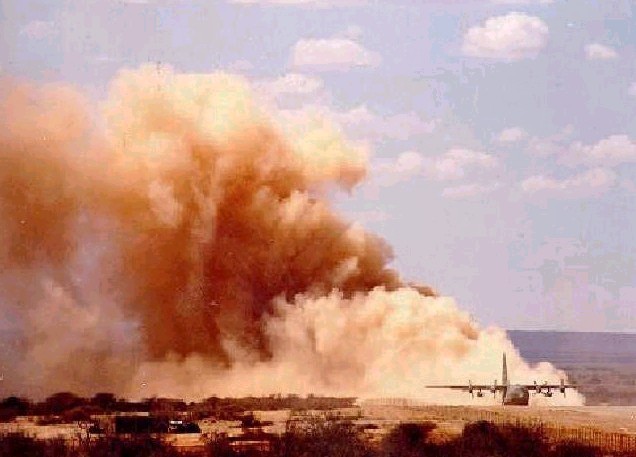
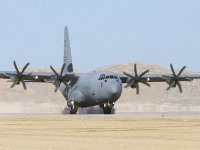
"...should the strip be laid out into the prevailing winds or not? During Desert Strike in 1963, 12 C-130's launched at five minute intervals from Pt Magu NAS to a desert strip for an air assault mission. The strip was laid out into the wind, which was blowing gently right down the runway. The first bird in used full reverse to stop on the rather short field, and the resulting dust cloud completely obscured the field for about 15 minutes. The rest of the mission aircraft started to back up in informal holding patterns waiting for the dust to clear. It was chaos to say the least. The lesson learned and probably forgotten was to offset the runway 30 degrees or so to allow the dust to blow sideways off the strip and allow operations to continue more or less unrestricted. I have no idea what the manual says about selection of an assault landing strip today, but I think you need to take that dust cloud into your considerations. It was this same concern about the ground environment that caused me to include a requirement for 'powered wheels' in the 1970 AMST TAC ROC 52-69. Envision an airplane landing and then shutting down all engines while moveing about on the ground with powered wheels. Of course, the idea was propably not practical when the engineers calculated the size of the drive system needed. Anyway it never came to anything. I can tell you that every time I see a picture of the C-17 operating on a dirt landing field, all I can see is the humongous dust cloud in the background. What a great aiming point for enemy mortars!!!
One of the contributing factors to the Desert One collision was the immense amount of dust kicked up because the C-130s had to keep their engines running out of fear of not being able to restart them. The C-130 now has water landing pontoons that can be added. Why not a set of powered wheels that lower to the ground with the rear ramp to propel the C-130 forward without need of the engines on? With powered wheels, the C-130 can taxi back with engines OFF or in low idle to an upwind take-off point if needed--even by backing up in reverse---without obscuring the assault strip for minutes afterwards. Below is my conception of this modified rear ramp which could be retrofitted to ALL C-130s.
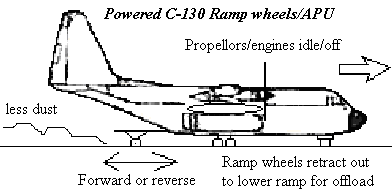
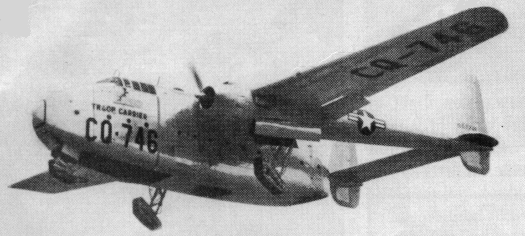
The C-17 can back up by special reverse thrusters, why not the Herk? Power ramp wheels if done right could also help the ramp withstand more roll on/off weights. The next Generation of Herks should land by Air Cushions or tracks (see pic above) to reduce the ground pressure as well as move over the ground without need of propwash. In WWII, an experimental caterpillar track main undercarriage was tested on A-20C serial number 41-19158.
WATER TRAILER DUST DAMPENER?
SEAL THE DIRT WITH A QUICK-DRYING SPRAY: ENVIROTAC II
PROBLEM:
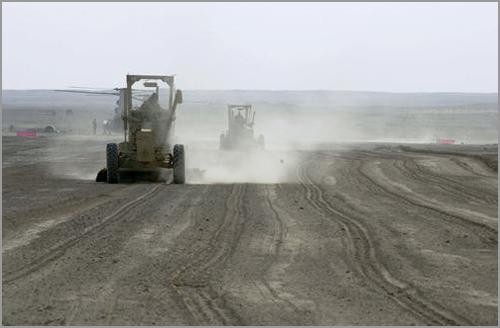
Another bad reality is that when you land high-ground pressure rubber-tired aircraft onto dirt assault zones, they rut the surface. As shown above from the southern Afghan airbase, engineers will have to constantly resurface the runways to prevent dust and ruts, taking time and effort. Refer to the report at the bottom of this page. So while wheeled aircraft can land onto dirt assault zones, it would be much better if they had TRACKED or ideally air cushion landing systems so the surface condition of the area will not be a limiting factor.
Concrete runway fixed air bases are vulnerable and must be avoided! Otherwise enemy surveillance strike complexes (SSCs) could wipe out our air forces on the ground!
However until we can make our aircraft more expeditionary via tracked/air cushion landing gears, we can operate from assault zone dirt runways by COATING THEM with Envirotec II also known as "Rhino Snot".
SOLUTION:

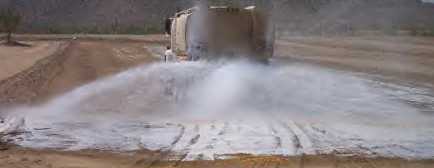
www.special-operations-technology.com/article.cfm?DocID=536
Special Operations Technology Online Archives
This article was Originally Published on Jul 13, 2004 in Volume: 2 Issue: 4
Preventing Brownout
EXCERPT:
Please, Get Snooty
"As everyone knows, this stuff saves lives," said Justin Vermillion, vice president, Environmental Products and Applications Inc. He's been getting lots of calls from the military for his Envirotac II as America's commitment to desert combat becomes protracted. With the majority of aerial accidents attributed to brownouts, chemical treatments that keep the dust down are getting serious attention.
Vermillion's acrylic polymer dirt control solution has been in high demand and given him some insight into the mobile military's dust dilemma. "The Army needs to extend the life of its equipment, and after we've sprayed the kinds of surfaces they are trying to land on with our polymer, we really increase that assurance level," he said. Camp Rhino in Afghanistan had a serious need to reduce brownouts. There, troops began using the Envirotac II as a soil stabilizer and nicknamed it "Rhino Snot." The substance soaks into the ground to around 3/4 of an inch and has been landed on by C-17s, C-5s and several makes of helicopter.
But tank treads can pull up the polymer, said Vermillion. "But tanks will pull up asphalt, too. It's best for aircraft-we liked the moniker of `rhino snot' so much we immediately put a copyright on it. The imagery's accurate in terms of toughness for the desert runway and ramp environment. It's a much cheaper way to go than replacing multi-million dollar aircraft after one of the mini-dust storms a helicopter will kick up.
"Our experience is that this silty sand can actually cause fires. So there is a real need to develop something solid to land on. We're looking at around five cents per square foot," he said. During initial operations in March 2003, brownouts plagued helicopters and other aircraft landing in the Iraqi climate, causing several crashes.
www.construction.com/NewsCenter/ Headlines/ENR/20020225b.asp
During the month the base was in use, heavy transport aircraft, including the 585,000-lb Globemaster C-17s, arrived nightly. Their landing gear gouged huge gashes into the unpaved surface. Cooke says the big planes left ruts 18 in. deep and their wash blasted oceans of soil into the air. "This kind of soil and terrain is pretty common in that part of the world, but when it is hit by an aircraft it is more like moon dust and talcum powder than sand," Cooke says. "When a plane lands it pulverizes what little hardpan is on the land. It's more like fireplace ash."
Helicopter pilots throughout the theater of operations are plagued by blinding brown-outs as they return, resulting in hard landings and broken landing gear. Some crashes resulted in injuries and fatalities. At Rhino, the Seabees improved helicopter landing pads using scrap metal and clay. Maintaining the helicopters was complicated by their stations close to the dust-choked runway, a position needed to keep the security perimeter tight.
Cooke says the Seabees did a lot of seat-of-the-pants engineering but as soon as they established satellite communications over SIPRNET, an Internet protocol router network for classified communications, and NIPRNET, an unclassified channel, they started long-range collaboration. "We were looking for assistance for engineering-drilling a well, stabilizing the dirt runway, controlling the dust," says Cooke. "We were sending images back and forth over the SIPRNET nonstop, along with urgent requests for parts."
"We had so little equipment there we had to have critical priority on parts," he says. If a grader broke down and runway maintenance fell behind it could have interrupted the airlift and compromised the mission. "The mechanics stayed out there with the operators. Sometimes right on the runway we had to do maintenance to keep them running," Cooke says.
One of the Seabees' first tasks was to dig a 6-ft-deep test pit by the runway, digitally photograph the wall and transmit the image back to supporting engineers in Bahrain and Hawaii for geotechnical advice. The Seabees also needed water badly, and asked for help in finding it.
Supporting engineers accessed NIMA's data, studied the remote imagery and geology of the area and came back and told the Seabees where to drill. But there was a catch. In order to tap groundwater, supporting engineers told them they would probably have to drill to 600 ft to meet their needs. After considering the probable length of the mission, the time it would take to drill and the logistics of flying in equipment and enough 10-in. casing and 4-in. draw tube for the job, Cooke says the Seabees decided that flying in "bulkwater" made more sense. "We decided to try and squeak by without it," Cooke says.
Water was needed for dust control and runway repair. Cooke says the top 3 ft of lakebed was like clayless moon dust. Below that, however, there was some clay. "So between landings we dug borrow pits off the side of the runway to find that clay...took whatever bulkwater we had and created improved dirt patches on the runway," Cooke says.
At dawn each day they started repairs by scraping away the previous night's rutted surface. Then, they would pick the worst spot and rebuild it by laying down a 3- or 4-in. layer of clay, wetting it, rolling it, and repeating the process over and over again. They could improve 400 ft to 600 ft each day this way, and the patch would last four or five nights before it was trashed again. It helped, but it was a stop-gap method and not a solution. With more than 6,000 ft of runway, the Seabees were not exactly gaining.
After time, the entire runway began sinking to the point where a front-end loader had to follow the graders to pick up the spoil and throw it over the growing berm along the side. The airstrip also began taking on a concave profile from the wheels tracking down the center, a circumstance that required additional periodic grading to restore flatness.
The machines worked the runway from sunup to sundown and between landings at night. "Whoever landed first each night got a pretty good ride. Everybody else had to pay the price," Cooke says.
At the same time, supporting engineers in Hawaii were tracking down a dust control product called Envirotac II that had been tried on marine maneuvers in Arizona a few years earlier. Justin Vermillion, vice president of Environmental Products and Applications Inc., Envirotac's Wildomar, Calif., manufacturer, says he began to get a series of phone calls and urgent requests for test samples.
The product is a syrupy "goo" that is mixed with water and applied as a top dressing to harden loose soil, he says. Vermillion's sample was quickly approved, and by Dec. 12 he had filled two 5,500-gal bulk trucks with the product and driven to a waiting C-17 at March Air Force Base in Riverside, Calif. Lacking the plastic containers needed for air-shipping the product, Vermillion says they picked up 206 used Pepsi drums from a feed store's horse trough inventory on the way to the airport and packaged the hardening agent on the runway as marines loaded the plane.
"Everything was from the hip, we didn't get PO numbers or anything," he says. "I didn't know it was going to Camp Rhino until afterward."
When it arrived, Vermillion says he got a telephone call from a Seabee engineer at Rhino. Cooke says they called because the kind of application they had in mind wasn't exactly covered in the product literature. "We were looking for a little insanity check," Cooke says.
Vermillion says he also learned the marines took to calling his product "Rhino Snot." That was all it took to give the product, which already had some other nicknames, a new moniker. The name stuck and so did the runway.
Environmental Products & Applications, Inc.
Manufacturer of Envirotac II Soil Stabilizer
73-710 Fred Waring Drive, Suite 220
Palm Desert, CA 92260
Phone: (888) 674-9174
Fax: (760) 779-1815
Mobile: (909) 908-3052
Email: Info@Envirotac.com
Website: www.envirotac.com
LAND-BASED "AIRCRAFT CARRIERS"
Roy Ardillo writes: "Survey the roads, plan where to place the equipment, fly the people and equipment in on lighter planes, and fly in the heavy lifters. It is my understanding that the C-17 can turn around within its own arc. But, it would make much more sense to me to have a runway part, an offloading part and a takeoff part.
If the planes land and take off into the wind, then this would solve the problems of ramp space, too. Gravel can be brought in to the offload area to get the equipment quickly away from the area.
I think it would look like this.
I===============I----------I===============I <-------wind
Landing----------------Offload-------Takeoff
2 x 3,000 foot highway section plus off load area ahead. C-130 or C-17 taxies all the way to FORWARD END of offload area; offloads. We could easily have 4 planes off-loading...just like a LAND-BASED AIRCRAFT CARRIER. Do off-loads fast (TAFVs are inside or push pallets off) and planes shuttle forward to take-off runway section---NO NEED TO TURN AROUND AT ALL AND TAXI DOWNWIND FOR UPWIND TAKE-OFF."
When not receiving USAF transports, we're only talking about 1,000 foot or less for Army AY-65 armored crop dusters, A-37s and OV-1 Mohawks doing this all the time from the land-based aircraft carrier.
USAF Correspondence Course Enrollment for learning Combat Control Tactics, Techniques, Procedures
1. Go to this site
www.maxwell.af.mil/au/afiadl/homepage.htm
2. On the left side of the screen you will see "Click here to open or close menu"
3. Click on the Air Force seal (an expandable menu will be visible)
4. Click on Course Catalog for courses to select;
Examples: (you will need 2 ECI Form 23s for the CCT Course)
1C251A - Combat Control Journeyman 1C251B - Combat Control Journeyman
5. Go back and Click on Student Administration
6. Click on Forms
7. Click on Downloadable Forms
8. Scroll down until you see ECI Form 23
9. You can then print out the form from there or here:
http://www.maxwell.af.mil/au/afiadl/registrar/eci23.gif
9. Complete ECI Form 23 (Example shown below)
Item 1 AFIADL Course Number Desired:
1C251A - Combat Control Journeyman
Item 2 SSAN: 123-45-6789
Item 3 Identity Category: 8
AFRES - EAD OFF 1
Marine-ACT/RES Q
AFRES - EAD AMN 2
Coast Guard-ACT/RES H
ANG -EAD OFF 3
AFRES - Non EAD OFF A
ANG - EAD AMN 4
AFRES - Non EAD AMN B
Reg AF - OFF 5
ANG - Non EAD OFF C
Reg AF - AMN 6
ANG - Non EAD AMN D
CAP 7
Foreign Military F
Army - ACT/RES/NG 8
U.S. Civilians P
Navy - ACT/RES 9
International Civilians S
Item 4 Name:
Sam Lee Damon
Item 5 Reason for Enrollment:
N
Code L-MANDATORY ENROLLMENT: Active duty Air Force, Guard, and Reserve personnel enrolling as required by regulations, manual, or other directive, i.e., those engaged in upgrade, lateral, qualification, or retraining programs under AFI 36-2201. NOTE: AFIADL Form 23 should not be used. Civilians of the international countries enrolling in job related CDCs must be enrolled as mandatory students using an AFIADL Form 23. Enrollment application should state "Employee of the US Government".
Code N-VOLUNTARY ENROLLMENT: Members of other military services, U.S. Civil Service (including non-appropriated fund) and USAF contractor employees (eligible IAW ETCA, Section F, Paragraph 6.9). Red Cross and other volunteers must include the statement: "Volunteer Worker". Active duty Air Force, Guard, and Reserve personnel enrolling in specialized or PME courses.
Item 6 Pay Grade:
O-9
Item 7 Testing Control Facility (TCF) Phone (DSN):
123-4567
Item 8 Address:
POB 1234 Fayetteville, NC 28307
Item 9 Test Control Facility (where you will take test) Zip code/shred of TCF:
12345-6789
Item 10 Course Title:
Combat Control Journeyman
Item 11 Signature and Title of Approving Official:
LTC Courtney Massengale
NOTE: Applications must be complete and accurate. Student enrollments and course records are computer processed. The student record file is maintained in course and SSAN sequence. Unless all necessary information is complete and accurate, the computer will reject the enrollment. Accuracy is imperative for enrollment processing.
10. Mail or fax it to the Registrar's office
Air Force Institute for Advanced Distributed Learning (AFIADL)
50 South Turner Blvd
Maxwell AFB-Gunter Annex AL 36118-5643
If you have any other questions concerning enrollment, you may contact the Registrar, Ms. Carol Smith at DSN 493-8128 or commercial (334) 953-8128 or through e-mail (carol.smith@maxwell.af.mil).
Webmaster: Mrs. Evelyn B. Milton, AFIADL/DT [evelyn.milton@maxwell.af.mil] DSN 596-3370 Comm 334-416-3370
Registrar's Mailing address:
AFIADL
Student Administration Branch
50 S. Turner Blvd
MAFB-Gunter Annex AL 36118-5643
Fax number: DSN 596-6143 or Comm 334-416-6143
NOTES
|
|
DEPARTMENT OF THE ARMY HEADQUARTERS, UNITED STATES ARMY TRAINING AND DOCTRINE COMMAND FORT MONROE, VIRGINIA 23651-5000
REPLY TO ATTENTION OF |
|
ATCD-SL (70) 21 Aug 98
MEMORANDUM FOR
SEE DISTRIBUTIONSUBJECT: Strategic Brigade Airdrop (SBA) in a Small Austere Airfield (SAAF) Joint Integrated Concept Team (JICT) Meeting Minutes
1. On 22 Jul 98, an SBA/SAAF JICT meeting was held to address a tasker from the 1997 Warfighter Talks. The meeting was co-chaired by representatives from the Army Training and Doctrine Command (TRADOC) and Air Force Air Mobility Command (AMC). A list of JICT members is at enclosure 1.
2. The Air Mobility Command provided full release for C-17 operations into SAAF's in Nov 97. Dimensional criteria and guidance for planning, design, construction and evaluation of assault landing zones was documented to conduct training and contingency operations with C-130 and C-17 aircraft in Engineer Technical Letter (ETL) 98-5. Appropriate changes to FM 5-430-00-02/AFJPAM 32-8013, Volume II, Planning and Design of Roads, Airfields, and Heliports in the Theater of Operations - Airfield and Heliport Design and AFJMAN 32-1013/E1 02C013 (TM 5-803-7), Airfield and Heliport Planning and Design are in process.
3. The topic which the JICT was tasked to address was the employment of the SBA into a SAAF. Specifically, the JICT addressed the issue as defined in the Warfighter Talks minutes, "...determine the true SBA requirement for austere field operations, and address how to meet the requirement through a combination of C-17 or other lift aircraft."
4. The JICT determined that, while there were currently no documents which contained a specific written requirement to insert an SBA into a SAAF, the Defense Planning Guidance (DPG) implies a requirement to be capable of such by its direction to provide a certain sized force anywhere within a defined timeline.
5. To determine this requirement, briefings and definitions were presented by members of the JICT to establish a common frame of reference for the JICT to work from. A copy of the meeting agenda is at enclosure 2. Further, the JICT addressed the specific questions as follows:
a. Is there a requirement to perform an SBA in a paved SAAF?
b. If so, can it be accomplished within the timelines/resources given by DA/Corps?
c. If there is a requirement to perform in a paved SAAF and it can't be operationally met, why not?
d. What changes/actions can be taken to meet the SBA requirement?
e. Is there a requirement to perform an SBA in a semi-prepared runway (SPR)?
f. If so, can it be accomplished within the timelines/resources given by DA/Corps?
g. If there is a requirement to perform in a semi-prepared runway and it can't be operationally met, why not?
h. What changes/actions can be taken to meet the SBA requirement?
6. A distinction was made between a paved and an unpaved SAAF, based on the joint service common definitions and the fact that the personnel and equipment demands to insert an SBA in a semi-prepared (dirt, gravel runway) are greater. The abbreviated definitions used by the JICT are at enclosure 3. It was discovered that the definitions used in the Engineer Technical Letter 98-5 which were forwarded for Joint publication updates were not consistent with the commonly agreed upon joint definitions. The ETL does not use the term "SAAF" nor define a SAAF, and contains a definition for a "Semi-prepared Assault Landing Zone (ALZ)" which is relatively close to the joint service agreed upon definition of an SPR.
7. To help establish a further frame of reference and common ground, the JICT used planning factors and assumptions in the performance of an SBA. These planning factors and assumptions are based on the results of the Joint Integrated Process Team (JIPT) for Strategic Brigade Airdrop, which was initiated by the respective Service Deputy Chiefs of Staff for Operations and Plans. In addition, the planning factors and assumptions are based on input from the XVIII Abn. Corps G-3 staff. A list of the planning factors and assumptions are at enclosure 4. It was identified early by the 82d Abn. Div. representatives that the Commander of the 82d had initiated a review of the composition of the SBA to redefine the SBA as only the Alpha Echelon (airdrop) element along with 10 airland sorties from the Bravo Echelon, which would insert the Immediate Ready Company (IRC) of tracked and other vehicles. However, it was the consensus of the JICT that since Corps and DA have not approved this idea, we would adhere to the current known planning factors. In addition, Corps/82d representatives stated the order of priorities for a target airfield was: 1.) international airport, 2.) paved SAAF, 3.) semi-prepared SAAF.
8. Discussions ensued using the questions as a guide to direct the JICT. As a result of these discussions, the following was agreed to by all JICT members:
a. There is an implied requirement, based on the verbiage in the DPG, to insert an SBA into a paved SAAF. This requirement can be met in the future with the current SBA assumptions/ planning factors as a guide, given sufficient C-17 aircraft. In the interim, it will require reliance on C-141's for personnel airdrop and a portion of the equipment airdrop, as well as an intermediate staging base (ISB) from which C-17's will shuttle the remaining airland portion. This concept is outlined by the JIPT for SBA to perform an SBA from FY 9704 to FY 0404. Use of an ISB is a short-term response since it is the only viable alternative available (ISB use introduces a greatly increased timeline outside of the SBA requirements and adds additional complexity and risk to the operation).
b. There is an implied requirement, based on the verbiage in the DPG, to insert an SBA into an unpaved SAAF (SPR). However, it was the consensus that, based on the current resources and time constraints, this could not be met with C-17 and/or other airlift. The reason for this is as follows:
(1) Based on previous testing on a semi-prepared runway, the time requirement to prepare a site could take from several hours to several days. This is not within the time line established for an SBA.
(2) Given the shearing force of C-17 braking and its effect on the runway surface, an SPR will have to be shut down for periodic maintenance. Because of the ambitious time line for the airland portion of the SBA (46 airland sorties within 20 hours to close the force within 24 hours; this equates to 26 minutes per aircraft to land, unload, refuel if needed, and takeoff), it was determined that there is no time to stop operations to perform runway maintenance.
(3) Engineers questioned the availability of an SPR that can accommodate at least a maximum on ground (MOG) of 4 aircraft.
(4) The division engineers may require augmentation from corps engineers to prepare and maintain the runway, since the current planned engineer runway package is insufficient for this task. This augmentation will be reflected in an increase in sorties to carry the additional equipment and personnel, thus increasing the overall time to perform an SBA.
c. An evaluation of the alternative courses of action to insert an SBA in an SPR was undertaken. The results are as follows:
(1) Increase the size of the airdrop package (echelon A) to reduce the airland package (echelon B). It was thought that since this option would reduce reliance on the runway and therefore reduce the frequency to perform runway maintenance, it presented a good case for meeting the SBA time line. However, the Corps and the 82d expressed concern over the increase in airdrop time and/or increased drop zone size or potential for increased equipment damage that could result from concentrating more equipment on the drop zone. Therefore, this option was ruled out.
(2) Increase the amount of engineer equipment and personnel. This option would allow for a greater number of engineering assets to prepare and repair the runway in a shorter amount of time. However, it was felt that the trade-off to this would be an increase in sorties to carry this equipment, which would increase the SBA time and may offset any time gained in the area of runway preparation/repair. In addition, even with additional engineering assets, given the rapid pace of the airland sorties it is unlikely the runway would not be closed for a time that would impact the current SBA time line.
(3) Use of alternate airlift instead of C-17. The C-141 and C-5 do not posses the capability to land in an austere runway or an SPR and were thus ruled out. In the future, there will be sufficient C-17's to perform the SBA mission into an SPR. However, because of runway maintenance requirements, the SBA timeline will not be met. In the interim, use of an ISB with C-17 shuttling the airland equipment as outlined in para. 8.a. above is the most viable option. Regardless of the timeframe, use of C-130's will require an ISB due to the nature of the C-130 and its cargo (approximately 4-5 C-130's for every C-17 load), speed, and range limitations (it is also questionable as to whether or not the number of C-130's needed at the ISB could be positioned in a timely manner overseas). The need to transload cargo will greatly expand the timeline and risk as previously mentioned. In addition, oversized and overweight loads (i.e. M-1 tanks, M-2 Bradleys, helicopters, etc.) will still require C-17's for the airland portion. Both C-130 and C-17 will require runway preparation, and even if C-17 delivered only the oversize/ overweight equipment, the runway would still need to be shut down for repair. Even if only C-130's could be used, it is highly likely the runway will need to be shut down for repair. This means the SBA timeline will not be met. Because of these reasons, in the near term there did not appear to be an advantage to using C-130's versus C-17's to perform sorties from an ISB to the SPR, and its use was therefore rule out.
(4) Extend the time line for an SBA in a SPR. This option to extend the time line to insert an SBA into an SPR beyond the 24 hours planned seemed to be the most logical and obtainable given the current scenario and resources available. While there is an inherent risk involved by increasing the time to mass the SBA in a threat environment, it was the most palatable option to the Corps and Division representatives, and was viewed by all as the only viable option.
9. The following recommendations came from the JICT:
a. DPG. During discussion of the SBA requirement, it was discovered that there is an inconsistency between the time stated for deployment of forces in the DPG and that which the Corps/82d is capable of and is planned for in the SBA. Recommend the Army staff elevate this to correct the time line in the DPG.
b. JIPT for SBA. The final meeting of the JIPT for SBA was held in Sep 97. However, several issues surrounding the SBA that are beyond the scope of this JICT still remain open. A time line for performing the SBA into an SPR that is acceptable to the XVIII Airborne Corps and DA needs to be established or the requirement deleted/redefined in the DPG. Issues surrounding aircraft refueling both in the air and on the ground remain, as well as a review of the tactics of getting the aircraft safely to the drop zone in such a large formation and aircraft spacing/delays for runway maintenance of an SPR. Recommend the Army staff resurrect the JIPT for SBA to draw these issues to closure and document the SBA concept, specific requirements and responsibilities in various joint and service specific publications.
c. On 4 Aug 98, TRADOC sent a memorandum to the Warfighting CINC's to solicit their comments on any currently scheduled or planned use of an SBA in a SAAF environment.
d. An attempt should be made to reach a common definition of terms once again, since those listed in the ETL are not consistent with previously published terms. This could be an action for the SBA IPT.
10. In summary, the verbiage in the DPG implies a requirement to insert an SBA into a SAAF, to include an SPR, through its directive to deploy a certain sized force anywhere within a defined time frame. This requirement can be met in a paved SAAF in the future, when sufficient C-17's are available. An SBA cannot be delivered into an SPR under the existing SBA assumptions, due to an inability to meet the time line for the airland portion. The inability to meet the time line is driven by the need to prepare and maintain the SPR, which will interrupt the airland aircraft flow. For this reason, it is recommended that the JIPT for SBA be resurrected to address these and other issues.
10. The POC for this action is LTC Svisco, DSN 986-9401, Comm. (937) 656-9401.
ORIGINAL SIGNED
4 Encls THOMAS SVISCO
(as) LTC, GS
Director, Army C-17 Requirements
DISTRIBUTION:
HQ, DEPARTMENT OF THE ARMY, ATTN: DAMO-ZXG
HQ, DEPARTMENT OF THE ARMY, ATTN: DAMO-FDJ
HQ, XVIII AIRBORNE CORPS, ATTN: AFGA-GT-OI
HQ, TRAINING AND DOCTRINE COMMAND, ATTN: ATCD-SL
HQ, AIR MOBILITY COMMAND, ATTN: AMC/XPRA
HQ, AIR MOBILITY COMMAND, ATTN: AMC/DOKT
HQ, 82D AIRBORNE DIVISION, ATTN: AFVC-GC
HHC, 20TH ENGINEER BRIGADE, ATTN: AFZA-AE-O
Encl 1
SBA/SAAF REQUIREMENTS INTEGRATED CONCEPT TEAM MEETING ATTENDEES
NAME ORGANIZATION PHONE #
LTC Thomas Svisco TRADOC/C-17 SPO DSN 986-9401
LTC John Miller G-3 XVIII Abn Corps DSN 236-6805
Mr. Jim Sova HQ TRADOC DSN 680-3005
MAJ Michael Bouie HQDA, ODCSOPS DSN 227-5093
MAJ Jim Daniel G-3 Air, 82d Abn Div DSN 239-0784
CPT Tim Frederick 20th Eng Bde DSN 396-5861
1LT Stephen Rhudy 20th Eng Bde DSN 396-5861
MAJ Dave Kasberg HQ, AMC/Tactics DSN 576-8416
LTC Eli Rosner HQ, 82d Abn Div DSN 239-0632
MAJ Mark Hunter HQ, AMC DSN 576-6458
LTC Kevin Lindsay HHC/20th Eng Bde S-3 DSN 236-2830
MAJ Mark Acker HQ, TRADOC DSN 680-2469
Encl 2
SBA REQUIREMENT FOR SAAF
JICT Meeting Agenda (Draft)
22 July 98
Time Subject POC
0900-0915 Introduction LTC Svisco
Purpose of the JICT
Tasker
0915-0945 Current/Future Army Requirements MAJ Bouie
Overview
0945-1005 Corps Mission Requirements LTC Miller
1005-1020 C-17 Capabilities/Planning MAJ Hunter
Restrictions
1020-1040 SAAF/Semi-prepared Runway LTCLindsay
Construction/Repair
1040-1055 Break
1055-1130 Discussion of Issues/Answer LTC Svisco
Questions
1130-1300 Lunch
1300-1600 Continued Discussion of Issue as
Needed
Encl 3
COMMON DEFINITIONS FOR SBA/SAAF JICT
SBA
The SBA is the responsibility of the XVIII Airborne Corps and is a division ready brigade task force, capable of rapid response time, surprise and rapid build-up of combat power, while reducing risk to air assets and providing operational flexibility. It consists of an Alpha Echelon (airdrop personnel & equipment) and a Bravo Echelon (airland personnel & equipment). Under the current CONOPS, the Alpha echelon will assault, seize and secure an area for the introduction of the Bravo Echelon. Ideally, this concept targets an area capable of handling up to four aircraft on ground simultaneously (maximum on ground - MOG) for a total of 46 aircraft in a 20-hour period.
Small, austere airfield (SAAF)
A SAAF is an unsophisticated, short airfield, incapable of C-141 or C-5 operations. It is usually in a forward operating area. SAAF's may have various surfaces including paved (prepared) or unpaved semi-prepared compacted surface (dirt, gravel, sand) runways and are typically limited in one or a combination of the following: material handling equipment, fueling capability, maintenance facilities, taxi ways, navigational aids, and parking space for aircraft ground operations.
Semi-prepared runways (SPR)
A subset of a SAAF, an SPR is an unpaved runway that has been prepared to safely support required aircraft maneuvers. The amount of engineering effort required to prepare an SPR depends upon the planned operations (i.e. number of landings), type of aircraft, the existing and required weight bearing capacity, and the existing soil and weather conditions. Runway preparation could take from a few hours to as long as several days. Consideration should also be given to periodic maintenance and resurfacing of an SPR during operations.
Encl 4
SBA PLANNING FACTORS/ASSUMPTIONS
The following planning factors/assumptions were used by the SBA/SAAF JICT to establish a framework for team members to work with.
1. The SBA delivers - via airdrop (echelon A) and airland (echelon B) - a brigade-sized Army force of the 82d Airborne Division directly from CONUS (whenever possible) to any target area in the world.
2. The mission of the SBA is to seize an area and establish a lodgment for expanded combat operations, as necessary.
3. An SBA could be employed as part of a larger combat operation or as a stand-alone mission to accomplish a Non-Combatant Evacuation operation or show of force.
4. Ultimately, the force package will be tailored to a specific mission, with the Division Ready Brigade (DRB) medium the optimum force for planning.
5. Items contained in the echelon B include some items that are too large to airdrop, such as equipment from the Immediate Ready Company (IRC).
6. Time constraints for the SBA are as follows:
- P-hour is first airdrop aircraft time over target.
- P+30 minutes is last echelon A aircraft airdrops load.
- P+4 hours is first echelon B aircraft lands at target area.
- P+24 hours is last echelon B aircraft lands at target area.
7. Target area characteristics included short, austere areas; likely with no organic air traffic control or cargo handling capability; were not compatible with C-141/C-5; and ideally should possess at least a maximum on ground (MOG) of four C-17's.
8. Airfield selection, requirements, and SBA composition will be METT-T (mission, enemy, terrain and weather, troops and support available, time available) driven.
9. Runway preparation and maintenance that exceeds the Rapid Runway Repair capabilities of the DRB force would require additional equipment be added to the SBA and heavy dropped. This equipment could come from either the airborne, light equipment company attached to the 82d Airborne Division (618th EN CO) or one of the two combat, airborne engineer battalions (27th and 37th EN BN's) under the 20th Engineer BDE.
10. Echelon B will require a total of 46 C-17 sorties.
FEEDBACK!
A 1st TSG (A) member who is a former USAF CCT writes:
"Mike, Thanks for the information. I enjoyed your site. I spent 22 years in USAF, Special Tactics Units (previously known as combat control teams). I have a lot of experience relating to your subject area. If I can help just let me know. I have used the phantom light. It is basically blue light (very low in the light spectrum)and it can be seen with NVGs but you have to be up close. It is made by a guy in VA Beach. Lots of marines have bought that light. Works great for map reading.
I am very interested in the [VS-21] panel you have mentioned. For the C-17, it's not the material that matters but the system used to suspend it. With two hundred mile per hour winds coming off the engines its got to be able to withstand the turbo jet blasts. I have seen chunks of asphalt, rocks, and large dirt clods come flying out of the ground as it revs up for take off. Currently I know of no tactics that require refletive IR runway marking panels for night operations except when used for marking turn off points, exit areas, stopping points or offload points. So even though your reference to this panel makes sense, unless someone incorporates it as a requirement it won't be used. The tactics for night time LZ operations call for white lights or IR lights for NVG operations. The box and one marking pattern for NVG landings is the one used most. Qualified mission capable crews can land blacked out---no marking lights required..
Just to comment on your opinion about airdrop vs. airland. I believe one is not necessarily better than the other. It is merely choosing the best tactics for the mission. An airland operation was the preferred method (first option)during Grenada. But because of delays that pushed us into daylight and the fact that the runway had been blocked with barrels, bull dozers, vehicles, lumber etc, the decision was made to jump in. Airfield seizure type airland assaults conducted at night can be more effective than an airdrop. But it always depends on the threats, the situation on the ground and the weather gods. By the same token the combat jump will always depend on the same factors. However, the airland option can give you lots of advantages over an airdrop. For example, in less that half an hour you can land a dozen planes to include C-5s, combat offload over two battalions, helicopters, jeeps, motorcycles, mortors. You can quickly launch helo assaults, dispatch vehicles to key blocking postitions and have a full compliment of communciations. The airdrop on the other hand can be very effective as well but your on foot and there are other risks such as injuries, disoriented Soldiers who become lost and the amount of time it takes to reconstitute. Since most of your information in the website refers to conventional airlands and airdrops you might want to contact the STS rep at the Pentagon. He can probably enlighten you a bit on some of the newer capabilities and tactics.
White lights on drop zones are used mostly for conventional aircrews. SOF Aircrews can drop with no lights or IR lights. However it is a matter of training to a standard and for now white lights is what the standard is. In the old days we used to light up the world for the aircrews. Two flanker green rotating beacons 1300 yds from the leading edge at the approach end, two white flankers closer in and the white letter A at the PI and an amber beacon at the departure end centerline. All this and they'd still miss the PI half the time. I spent four years in Alaska training with the Army, running airfields at Delta junction, Donnelly LZ, Malemute, and many more. Never remember the Army doing rapid onload and offload training. Not much rapid anything happens when it's 60 below zero like it was at Delta Creek LZ. Every morning we would have to pull in our snow machines into the tent to thaw out next to the yukon stove. Trucks would run all night cause once shut off they wouldn't start back up. Now that is cold. Anyway enough war stories. If I can contribute to your research let me know. I''ll be glad to help. Have a great Pentagon Day!!"
 Return to U.S. Army Airborne Equipment Shop
Return to U.S. Army Airborne Equipment Shop

